
Insight into ArtVilnius’21
October 15–17
Lithuania’s ArtVilnius art fair celebrated its 12th edition this year. With the participation of 56 galleries from 12 countries (Lithuania, Latvia, Estonia, Belarus, Ukraine, Russia, Romania, Albania, Denmark, France, Germany and Italy), the fair continues to prove itself a significant player in the eastern European art scene. Moreover, the absolute predominance of Lithuanian galleries may well lead a foreign visitor to wonder: how is it possible to have so many galleries in such a relatively small country? In fact, Lithuania has an impressive network of art galleries and centres, which includes galleries established by the state, municipalities, public organisations and higher education institutions as well as private galleries. In total, there are more than 50 galleries in the country today. In 1996 the Lithuanian Art Gallery Association was founded and the ArtVilnius art fair has been organised under its auspices since 2009.
Jurgis Tarabilda at the booth for the Meno Niša (LT) gallery 
Regarding the constrained situation due to the pandemic, ArtVilnius Artistic Director Sonata Baliuckaitė is grateful to the Lithuanian Council for Culture (LTKT) for its considerable support to the arts sector. (The individual grants programme implemented by LTKT can be found at: https://www.ltkt.lt/en/grants-for-the-arts). It should also be mentioned that the support for the arts coming from the country’s private sector is quite commendable. For example, so as to adhere to pandemic restrictions, the centre of Vilnius was transformed not only into a huge open-air café but nothing less than a large art gallery titled Art Needs No Roof. With the support of the municipality and the outdoor advertising company JCDecaux Lithuania, commercial billboards across the city showed the works of 100 artists.
This year’s attendance numbers and the patience of art lovers to endure the long queues at ArtVilnius ticket booths (visitors’ vaccination/test-status was carefully checked at the entrance) was also surprising. And in this era of epidemiological uncertainty, for the second year in a row now the fair’s organisers also implemented a 3D tour for those who could not attend in person. In total, more than 15 000 people attended the fair – a good figure considering the dictates of the pandemic and the fact that this year the fair was held over only three days instead of the usual four (in 2019 visitors numbers reached 23 000).
The DK Gallery (BY) booth
Although ArtVilnius may not be one of Europe’s blockbuster art fairs, it certainly is one where the everyday art lover buys works. As Baliuckaitė reveals, ‘Sales were good this year, with many artworks sold. Maybe the most expensive ones didn’t fly off the shelves, and perhaps one wouldn’t call the majority of buyers true collectors, but we can be proud of our wide range of art lovers and buyers. This year we also organised a special stand for new collectors featuring artworks priced under €500. Works on paper – drawings, collages, prints, etc. – were also well represented throughout the fair.’
Installation 'Priez pour nous, pauvres pécheurs' (Pray for us poor sinners) by the duo SetP Stanikas. Photo: ArtVilnius
Perhaps it is precisely the relentless activity of the fair’s organisers and the consistency of the happening that has made ArtVilnius a permanent fixture on the public’s calendar of yearly events. As one of the pillars of strength of the Lithuanian contemporary art process, the fair definitely gives an energetic boost to artists and galleries as well as to public interest and participation. Highlighting the artistic quality of the fair, Baliuckaitė adds: ‘ArtVilnius was also an opportunity to acquire artworks that should be in museum collections, such as the installation Priez pour nous, pauvres pécheurs (Pray for us poor sinners) by the duo SetP Stanikas, and the installation by Jurgis Paškevičius, represented by CAC. We invest a lot in promoting education – we talk about art collecting, the tradition of contemporary art in the world, and the latest trends, for example, with this year’s presentation How Soon is Tomorrow. Collecting NFTs by the Lewben Art Foundation.’
Anna Mari Liivrand at the booth for EKA Gallery (EE)
Sophie Durand at the booth for EKA Gallery (EE)
Jolanta Rudokienė and Vilija Balčiūnienė at the booth for Galerija XX (LT)
Booth for Šv. Jono Gatvės Galerija (LT)
Gérard Stricher at the booth for the Menų Tiltas (LT) gallery
Vilmantas Marcinkevičius at the booth for Galleri NB (DK)
Eclectic Aesthetics
The gallery exhibitions at this year’s edition of the fair were characterised by marked contrasts of aesthetics – from elegant and subdued booths, such as those of the Estonian Academy of Arts’ EKA Gallery with works by Sophie Durand and Anna Mari Liivrand, and Panevėžys’ Galerija XX with graphic works by Jolanta Rudokienė and ceramics by Vilija Balčiūnienė, to loud and colourful booths such as those of Vilnius’ Šv. Jono Gatvės Gallery featuring landscape paintings by Mykolė Ganusauskaitė, the Menų Tiltas (LT) gallery’s booth presenting works by French abstract expressionist artist Gérard Stricher, and the booth for Denmark’s Galleri NB, which represented Vilmantas Marcinkevičius, a Lithuanian artist whose latest works reflects on these times of the pandemic and the human brain’s adaptation to a new way of life and new creative thoughts.
Booth for Agijas Sūnas Mākslas Galerija (LV)
Booth for Agijas Sūnas Mākslas Galerija (LV)
Booth for Galerija Bastejs (LV)
Latvia was represented by three galleries: the Agija Sūna art gallery, with paintings by Irēna Lūse, Signe Vanadziņa and Dita Lūse; Gallery Bastejs, with geometrically precise works by Henrijs Preiss, portraits by Ritums Ivanovs in his unique linear technique, and photo/ink and mixed media works by Kristians Brekte; and PILOT, the experimental art space of the Art Academy of Latvia (LMA) with selected works of academy students and graduates, and again - Kristians Brekte, the head of the academy’s Painting Department.
Booth for Galerija Kristina Norvilaitė (LT)
Three days after the fair closed, Arterritory.com contacted the event’s organisers about the sales results. Rasa Barčaitė, the communications manager for ArtVilnius, informed us that the organisers are more than satisfied overall, but cannot yet announce the exact results because many transactions are still in progress. ArtVilnius is also pleased with its new international contacts which will bring new opportunities for cooperation with European art institutions and curators.
Alexej Tchernyi at the booth for Aambulanz Kollektiv (GE)
Gustas Jagminas at the booth for the Meno Niša (LT) gallery 
Ievgen Petrov at the booth for the Tsekh (UA/LT) gallery
Mykola Bilous at the booth for the Tsekh (UA/LT) gallery
Egmontas Bžeskas at the booth for the Kauno Langas (LT) gallery
Aistė Ramūnaitė at the booth for the Kauno Langas (LT) gallery
Gintarė Stašaitytė at the booth for Galerija Arka (LT)
Booth for Galerija Kristina Norvilaitė (LT)
Booth for Karavan Gallery (FR)
Ramūnas Danisevičius at the booth for Galerija MOrka (LT)
Nana Rosenørn Holland Bastrup at the booth for Galleri NB (DK)
Vytautas Tomaševičius at the booth for Trivium (LT) gallery
Booth for the IAGA Contemporary Art (RO) gallery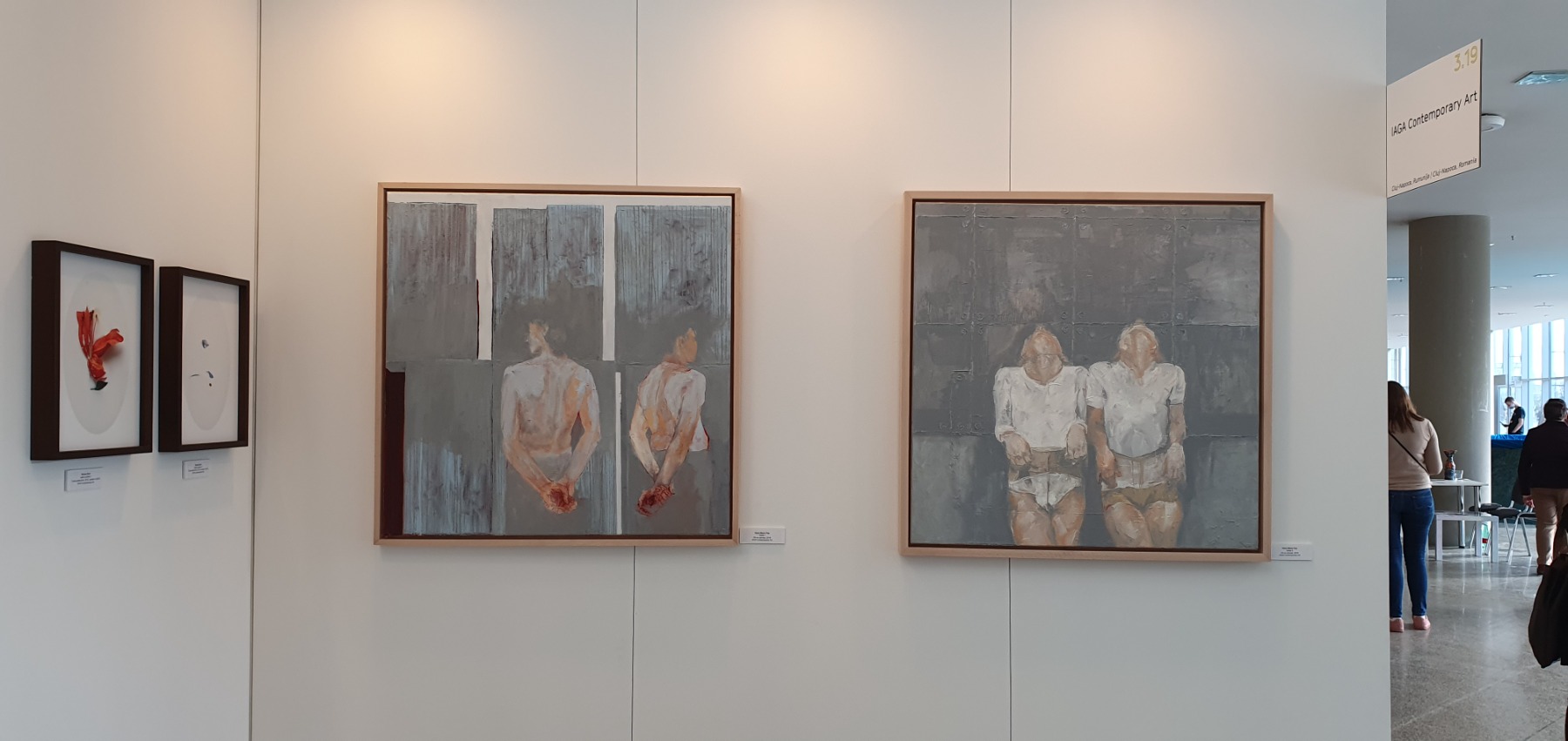
Installation by Tomas Daukša / The Rooster Gallery (LT)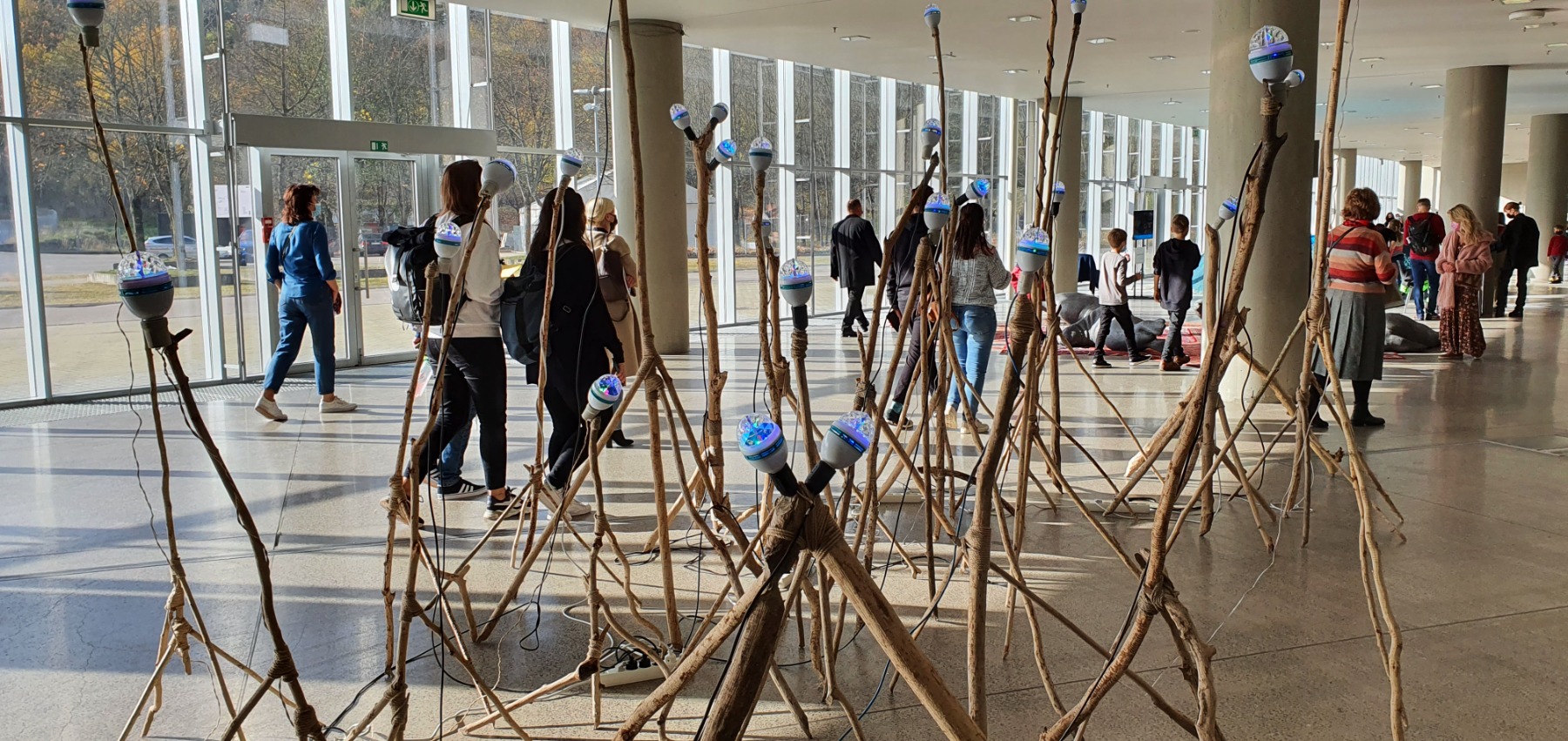
Liutauras Griežė at the booth for Antakalnio Galerija (LT)
Alexej Tchernyi at the booth for Aambulanz Kollektiv (GE)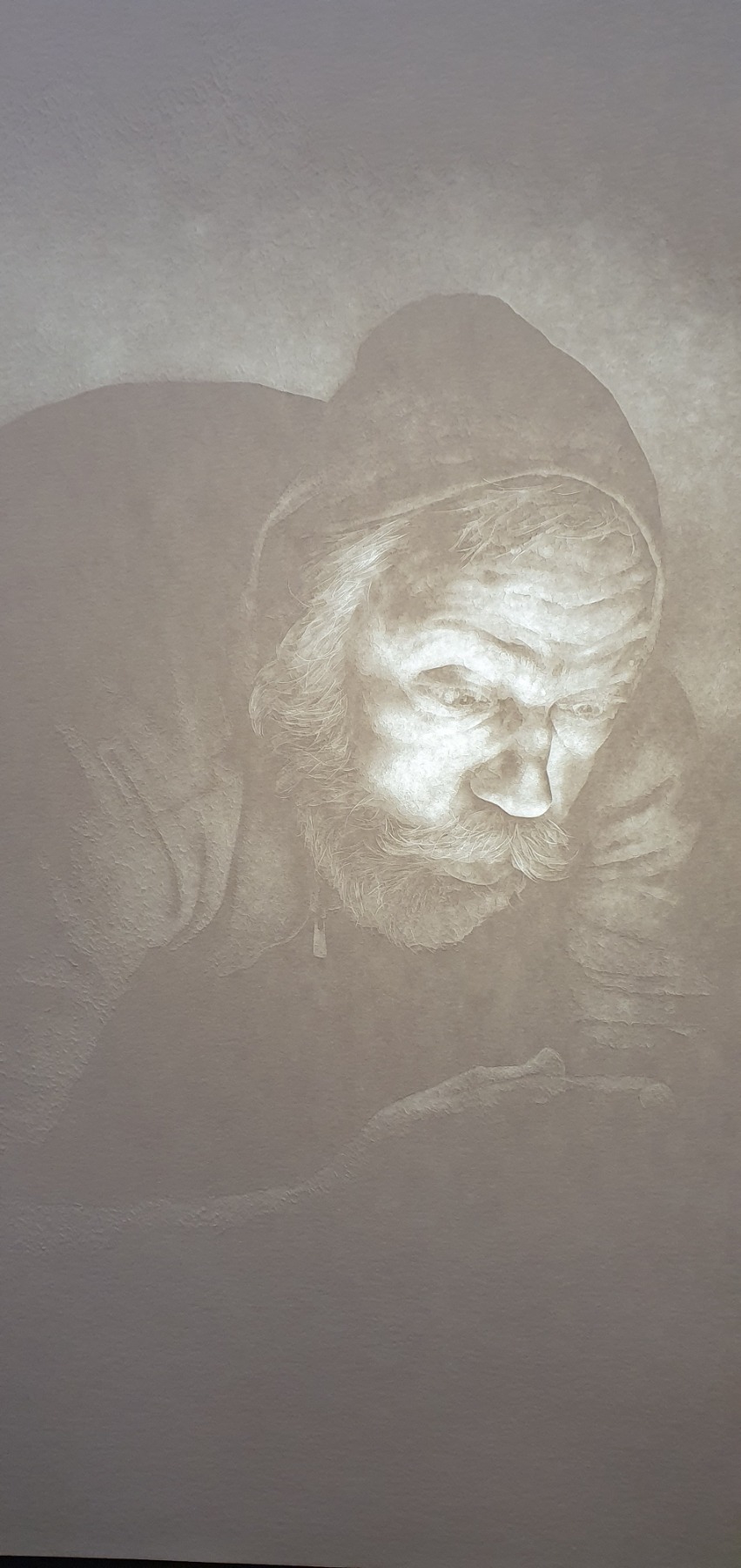
Vytenis Lingys at the booth for the Menų Tiltas (LT) gallery
Takas – a programme giving balance and dynamics to the fair
ArtVilnius once again presented Takas, an international exhibition programme of large-format sculptures, installations and performances started 12 years ago. Featuring 22 artists this year, the curator of the programme was Vytenis Burokas, himself an artist, Curator of Exhibitions and Education at the National Gallery of Art, and a lecturer at the Vilnius Academy of Arts, Department of Sculpture.
Dalia Truskaitė (LT). Nepasakyti, 2017 (Awarded Best ArtVilnius’21 Installation)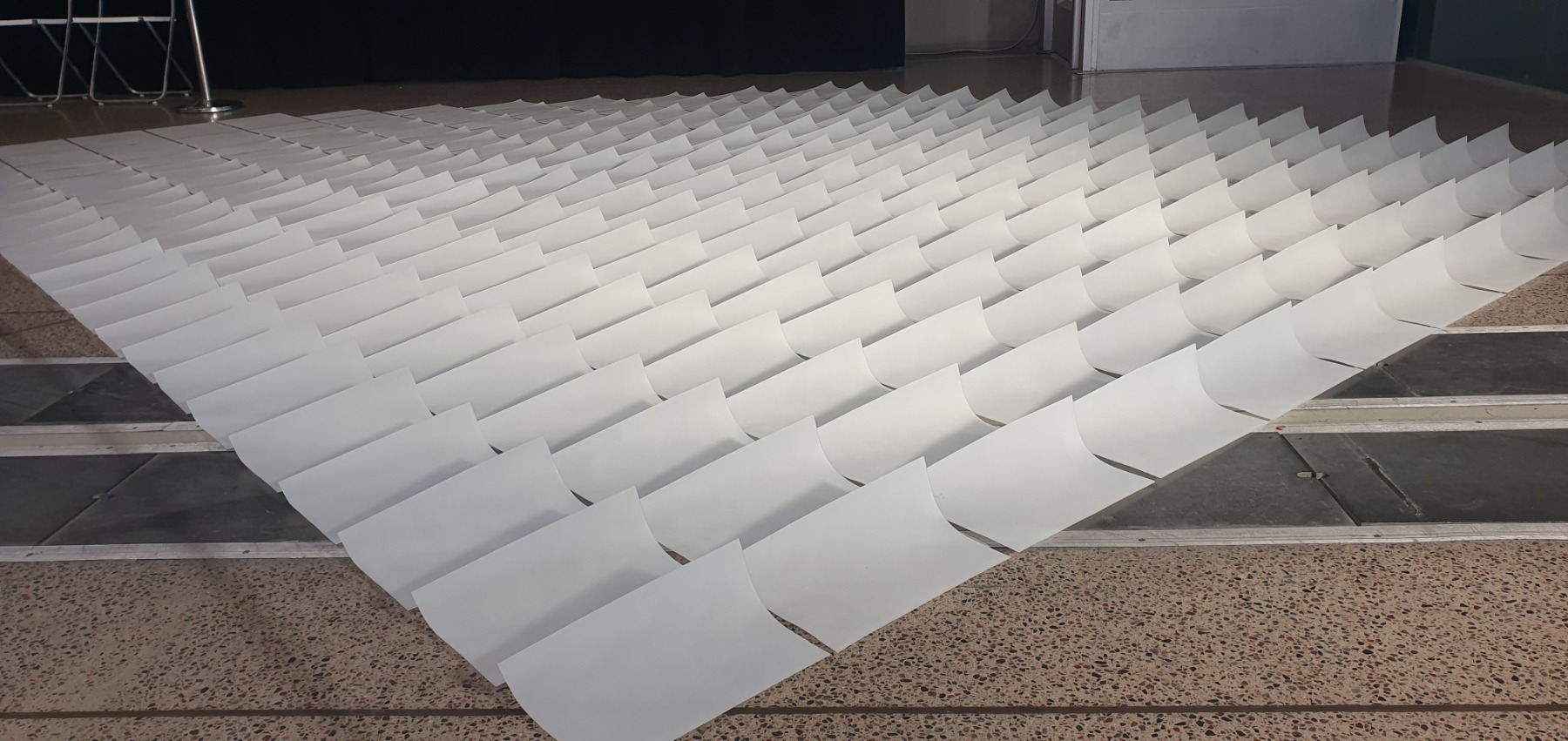
Matas Janušonis (LT). Iškabos, 2020
The works selected for this year’s Takas programme particularly stood out with the featured artists’ efforts at challenging materiality. For example, at first glance, Dalia Truskaitė’s installation Nepasakyti (2017) suggests that it is nothing more than a simple layer of white sheets of paper – that is, until you realise that these delicate sheets are actually made of fragile glass. Similarly, Matas Janušonis’ site-specific work Iškabos, in which shop signs are taken out of context, forces the viewer to look more closely at their fundamental materiality and form.
Kęstutis Svirnelis (LT/GE). Balance
Domas Ignatavičius (LT). Siurbiantys, 2021
Goodhearter Wisher, formerly known as Vytautas Viržbickas (LT). (Awarded Best Participant in the exhibition Takas) 
Vytautas Viržbickas illustrated that the majesty of antique architectural columns can be achieved from such a mundane material as shredded rubber automobile tyres, concurrently giving them an association with natural forms. The work in the exhibition centre’s outdoor space became the central event, in a way balancing the monetary nature of the art fair with its modest choice of material.
Domas Mykolas Malinauskas (LT), Preserved In Time, 2021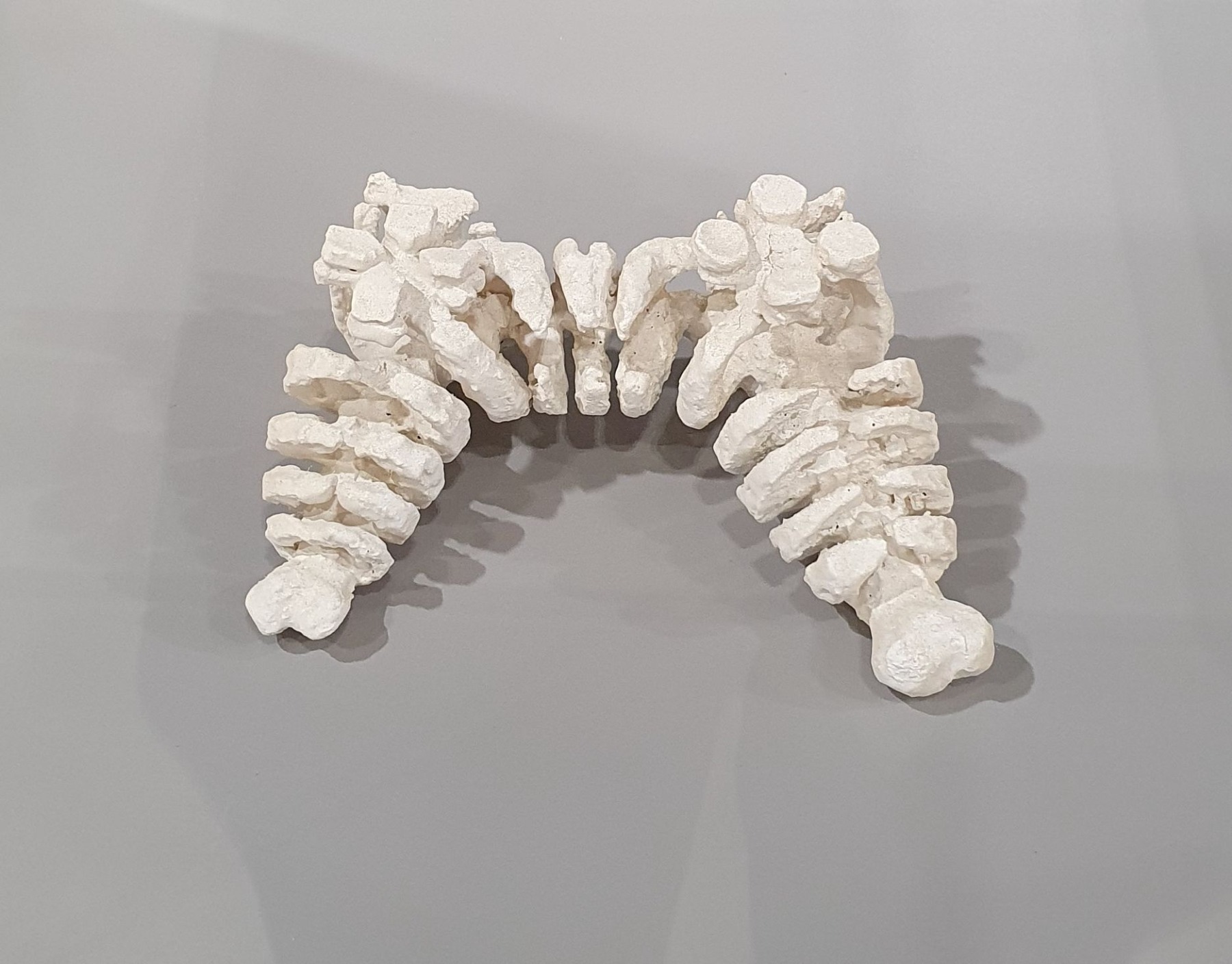
Meanwhile, sculptor Domas Mykolas Malinauskas, with his fossilised popular culture cult objects (game controllers, Coca-Cola cans, a Pokémon ball, etc.), invites us to think about what will be left of our everyday materiality in a few hundred years, when future archaeologists dig up the ground to see what we were like.
Tauras Kensminas (LT). Vilniaus baziliskas, 2021
Andrius Erminas (LT). Įvykio vieta, 2021
Mykolas Sauka (LT). Galvos, 2020-2021
Last year the installation Garden by Rafal Piesliak, a participant in the Takas exhibition, was purchased by Irmantas Norkus, managing partner of the law firm Cobalt and a long-time patron of the fair, who donated the work to the City of Vilnius. We asked Vytenis Burokas about the place of sculpture and installation in the overall tradition of art collecting, as well as in the Lithuanian public space. ‘It is always connected with strong, determined individual initiatives. For example, when the MO Museum building designed by Libeskind was completed, work started on the public outdoor space, where a number of sculptures were placed. Although the museum is privately owned, the sculptures are accessible to all visitors and residents of the city. There are some collections in Lithuania that contain contemporary sculpture, objects and installations, but clearly these media cannot compete with, for example, contemporary painting. The works are purchased from the Taka programme. However, such donations to the city are not altogether easy to realise. There is a lengthy approval procedure before the work can actually be placed in the urban environment. The works must have added cultural and artistic value so that they are meaningful for generations to come, not just put out as “icing on a cake”.’
Performance by Edvinas Mikulskis (LT), 2021. Photo: ArtVilnius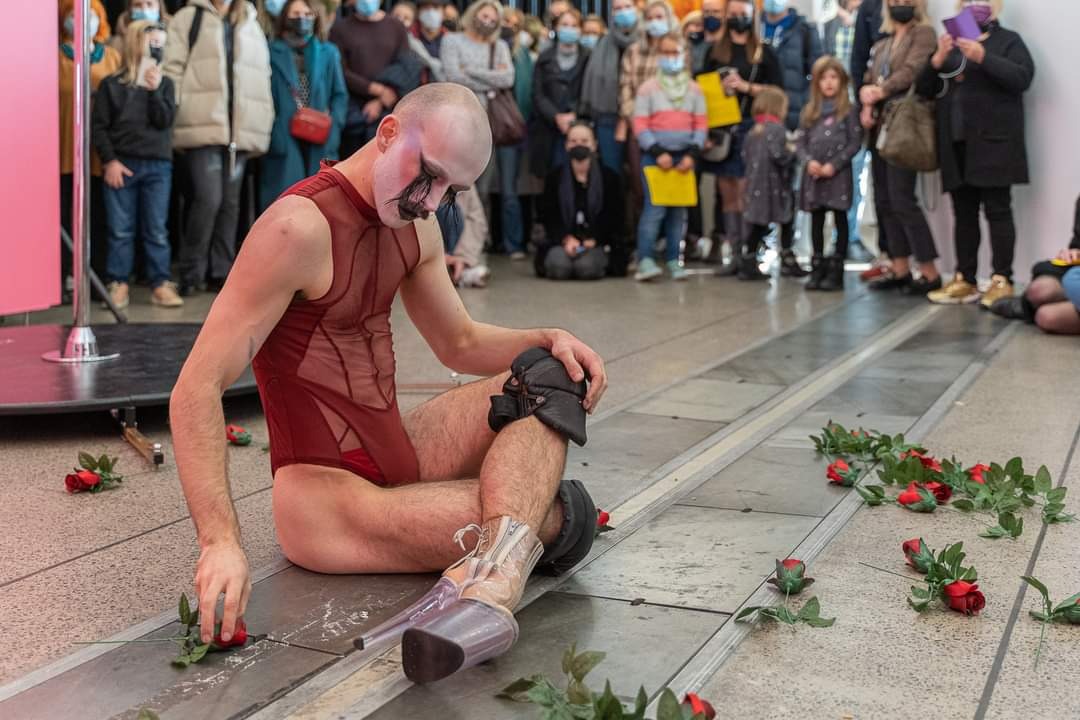
Performance by Monika Dirsytė (LT), 2021. Photo: ArtVilnius
The performance art section also added a certain dynamism to the overall atmosphere of the fair, where, alongside Lithuanian artists Nancie Naive, Gabrielė Vetkinaitė and Edvinas Mikulskis, the audience once again waited with bated breath for Monika Dirsytė to appear. What will she do this time? In answer, the artist tested the limits of her physical endurance by balancing on a small foam mattress in a pool of cold water – for eight hours daily over the three days of the fair. It should be mentioned that the artist’s body was already visibly shaking due to the cold after the first 20 minutes.
Galerie Nivet-Carzon (FR). Béguin Maureen. The performance Mmmmh was shown at the booth throughout the three days of the fair
Four galleries contributed to the fair with their performance programmes – Lithuania’s Nivet Carzon, Okapi, and the Vilnius Academy of Arts gallery Malūnų 5, all of which presented their performances in their booths, and GOM/TAC from Albania, which showed theirs in the urban environment. What’s more, the Artistic Director of the fair shared the news that in the summer of 2023, the gallery Meno Niša will organise an international performance art biennial. When asked how open and ready Lithuanian audiences are for performance art, Burokas replied: ‘As in all post-Soviet countries, there is a very specific understanding of what art is in general. It’s quite clear that this is just sculpture and painting, and that any further development of this understanding has become stuck somewhere. Often you hear the older generation disparagingly saying, “that’s just another performance”, when they see anything that doesn’t fit into their firmly set framework. And then, in complete contrast – Boom! Lithuania receives the Golden Lion at the Venice Biennale, and specifically for performance art (Rugilė Barzdžiukaitė, Vaiva Grainytė and Lina Lapelytė for the opera/performance Sun&Sea in 2019). Well, well, it turns out that our artists really are creating works that are being recognised internationally! And the work was so good that it was well received by the general public here in Lithuania.
Performance by Monika Dirsytė (LT), 2021. Photo: ArtVilnius
Monika Dirsytė also receives undivided attention with each of her appearances at the Vilnius fair. She travels all over the country with her work and is well received outside the capital. You see, you can try to educate people, but performance art, with its archetypal psychological aspect, is something that attracts anyone who has empathy.’
Highlights of the fair
As every year, the jury, led by Laima Kreivytė, an independent curator, artist and lecturer at the Vilnius Academy of Arts, selected – alongside Best Artist, Best Young Artist, and Best Sculpture/Installation – seven Best Galleries. There was also a public vote that determined the Visitors’ Favourite gallery. Given the significant number of visitors and interest in this year’s edition of the fair, the result of the public vote was significant, with the award going to PILOT, the experimental art space of the Art Academy of Latvia (LMA) founded with the aim of creating a unified European platform for higher art education.
Team of Pilot, the experimental space of the Latvian Academy of Arts (Riga). Photo: ArtVilnius
Among the artists whose works were selected for the fair’s exhibition were academy students and graduates (Amanda Krūmiņa, Ieva Dzelde Mierkalne, Miķelis Mūrnieks and Rūdolfs Štamers), and from the faculty, Kristians Brekte, the head of the academy’s Painting Department who happens to be well-known and recognised as an artist in Lithuania as well. Sabīne Vernere, the manager of PILOT and the exhibition’s curator, explained that the selection was made with the idea of representing what is happening at the academy by showing vivid works and ‘going a bit wild’. She also points out that there is a great deal of public interest in the technical solutions of the works, as the exhibition stands out due to the unusual techniques used by the artists. The LMA has been participating in the Vilnius fair since 2013, and always with good results.
Artifex. VAA textile gallery (LT). Severija Inčirauskaitė-Kriaunevičienė and Rūta Šipalytė
Among the seven Best Galleries selected by the jury this time were: Artifex, the textile gallery of the Vilnius Academy of Arts, with a striking use of materials by Severija Inčirauskaitė-Kriaunevičienė and Rūta Šipalīte; Galerie Nivet-Carzon (Paris) with the engaging performance Mmmmh by artists Béguin Maureen and Le Doze Morgane; and GOM/TAC from Albania, newcomers to the fair who expanded their gallery booth throughout the city by way of a green taxi that drove around the city playing soundtracks created by 22 different artists. Also commended were the Lithuanian galleries Meno Parkas, Molėtai, and Titanikas, as well as the Vilnius Photography Art Center “7:14”, with works by Dovilė Dagienė-DoDA and Emilija Petrauskienė.
Presentation 'How Soon is Tomorrow. Collecting NFTs' by the Lewben Art Foundation
From left to right: Sabīne Vernere, director of the Pilot, the experimental space of the Latvian Academy of Arts (Riga), Kristians Brekte, artists and Agnese Čivle, art and culture journalist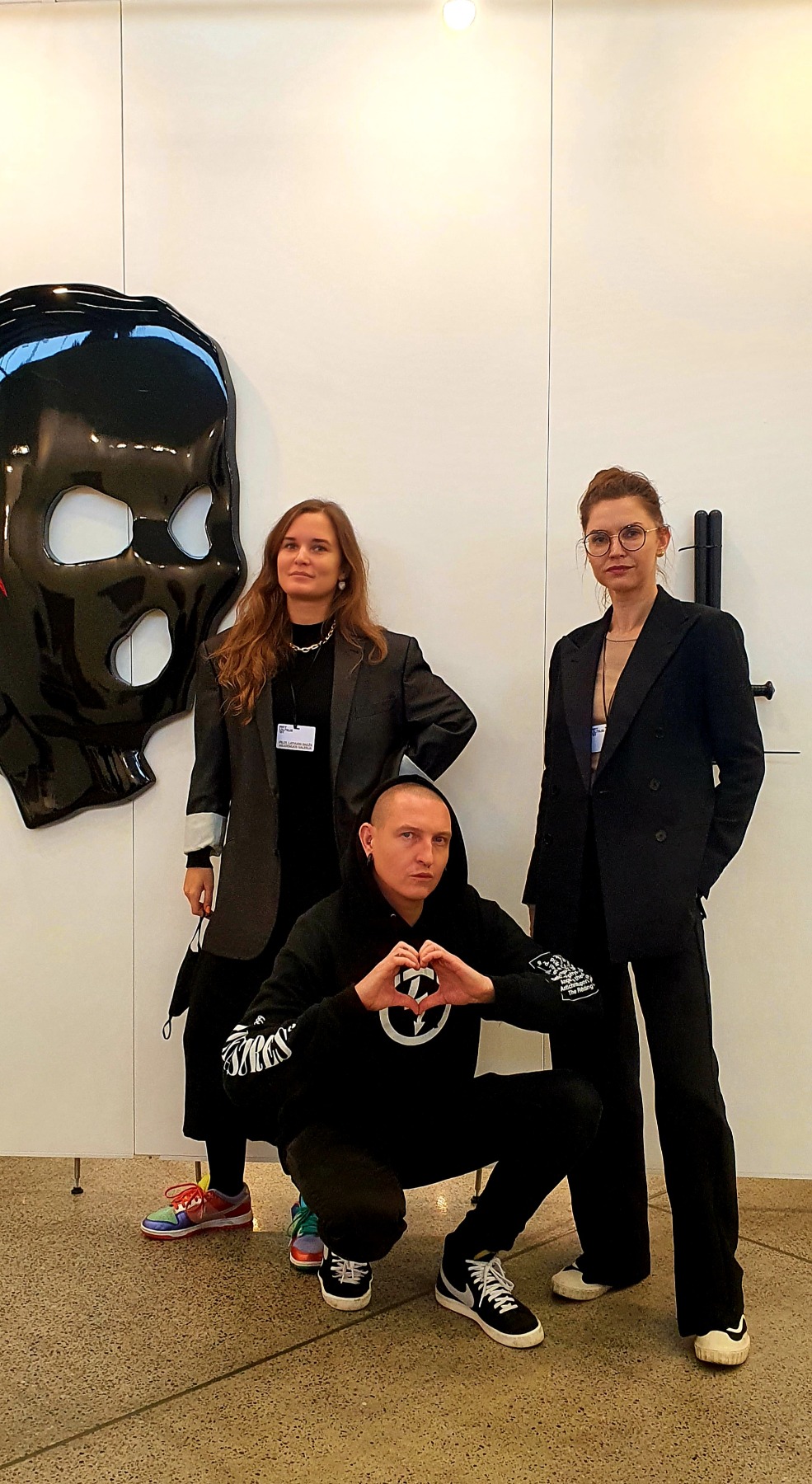
Agnese Čivle in the middle of the work 'Goodhearter Wisher' by Vytautas Viržbickas in the exhibition centre’s outdoor space 